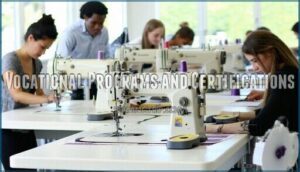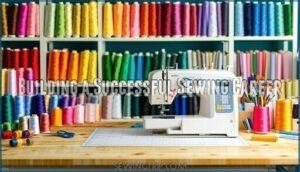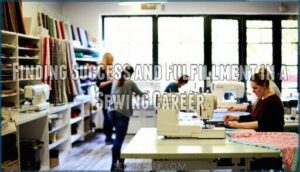This site is supported by our readers. We may earn a commission, at no cost to you, if you purchase through links.

Whether you’re freelancing, launching your own brand, or joining production teams, there’s room for growth and innovation. Hands-on training, networking, and a killer portfolio are your toolkit for success.
It’s not all smooth seams—competition and long hours are part of the pattern—but with dedication, sewing can transform from hobby to profession. Ready to unravel what makes this industry tick?
Table Of Contents
Key Takeaways
- Sewing offers diverse career paths, from fashion design and costume creation to textile technology and freelance entrepreneurship. – Success in this industry relies on a mix of technical skill, continuous learning, and strong connections through networking and portfolio building. – Earning potential varies widely based on specialization, location, and business approach, with opportunities ranging from modest salaries to high freelance income. – Dedication, adaptability, and a passion for creativity are essential for turning sewing from a hobby into a rewarding and sustainable profession.
Can Sewing Become a Career?
Ever catch yourself wondering if sewing could actually turn into a real career?
Let’s look at what makes this creative path possible and how you can shape your journey.
Understanding The Potential
It’s amazing how something as simple as a needle and thread can unlock a whole world of creative jobs and possibilities, isn’t it?
The sewing industry’s Market Value has surged, fueled by Industry Growth and a hunger for unique, handcrafted work.
Sewing careers span Diverse Careers, with Skill Demand rising as Career Paths multiply—proof that sewing skills are more relevant than ever.
Exploring Different Pathways
Sewing careers branch out far beyond the classic tailor’s bench. From Niche Specializations like embroidery to Industrial Roles in modern factories, the fabric of this industry is woven with endless Career paths. You may find yourself testing Freelance Opportunities, growing a presence with Entrepreneurial Ventures, or stepping into Production Pathways.
With so many sewing career opportunities, there’s a place for every skill set—and plenty of space for curious minds to chart their course. Many sewing business owners find that their annual income varies based on location and clientele.
Developing Skills and Expertise
Once you’ve spotted a path that excites you, building real expertise is all about rolling up your sleeves and letting curiosity guide your hands. Technical Proficiency and Design Acumen grow through hands-on experience—think late nights at the machine, creative exploration, and solving problems stitch by stitch.
Adaptability matters, too; the best sewing skills evolve with new trends and challenges. Skill development is a lifelong pursuit, weaving technical skills with bold creative vision.
Education and Training for a Sewing Career
If you’re ready to turn your passion for sewing into a career, you’ll find plenty of ways to build your skills and credentials.
Here are some paths you can explore to get started.
Vocational Programs and Certifications
Curious how to thread your passion into a real sewing career? Vocational programs and sewing certifications are your launchpad, blending hands-on learning with industry standards.
You’ll find Program Enrollment booming, with Curriculum Coursework covering everything from pattern drafting to machine mastery. A great way to develop your skills is through professional alterations training.
Job Placement assistance connects you to the heart of the sewing industry, where new skills meet real opportunities.
- Learn by doing, not just watching
- Earn credentials that open doors
- Join a community that values craftsmanship
Degree Programs in Fashion Design or Textiles
If you’re interested in Fashion Design or Textiles, these degrees open doors to both creativity and technical skills. You’ll dive into everything from digital design to textile science, all while building your own style.
Top schools like FIT and Parsons also offer hands-on internships and strong industry connections, so you’ll be ready for the real world.
Check out the table below for a quick snapshot of what to expect:
| Specialization Options | Graduate Salaries |
|---|---|
| Fashion Design | $80,690 median |
| Textile Design | $52,291 average |
Apprenticeships and On-the-Job Training
If you’re keen to learn the ropes in the sewing world, nothing beats rolling up your sleeves and diving into an apprenticeship or on-the-job training alongside seasoned pros. Through hands-on experience, you’ll develop sewing skills that stick, benefit from mentorship, and build genuine industry connections. Practical application trumps theory here—vocational programs and mentorship programs open doors you simply can’t access alone.
- Real-world feedback on every stitch
- Individualized guidance from experts
- Skill development at lightning speed
- Access to insider tips and techniques
- Confidence to tackle challenging projects
Job Opportunities in The Sewing Industry
The sewing world is full of possibilities, each with its own unique rewards and challenges. Here’s a look at some of the most sought-after roles you can pursue.
Fashion Designers and Seamstresses/Seamsters
Ever wondered how your sewing skills could shape the fashion industry? Fashion Designer Employment Trends show 43,320 designers thriving in the U.S., especially in hotspots like New York and California.
Seamstress Skillsets—pattern mastery, garment construction—open doors to self-employment and specialty shops.
Salary Expectations range from $61,875 to $126,458, with Career Progression fueled by experience, creativity, and a sharp eye for detail.
Costume Designers and Tailors
Imagine stepping behind the scenes, where your needle and vision transform fabric into living stories for the stage or create one-of-a-kind garments that fit like a second skin.
Costume Designers and Tailors thrive on costume accuracy, adapting tailoring techniques that honor historical costumes or introduce modern flair. Every stitch matters in custom tailoring and wardrobe maintenance, bringing drama, authenticity, and comfort together.
If precision excites you, consider:
- Custom fitting for performers
- Re-creating period ensembles
- Overseeing wardrobe upkeep
Textile and Apparel Technologists
Curious how yesterday’s fabric becomes tomorrow’s trendsetting jacket? Textile and apparel technologists are the wizards behind the curtain, marrying technical skills with creativity.
They shape the textile industry’s direction—think textile innovation, smart fabrics, and sustainable textiles—using material science to boost garment production.
In the fashion industry, they’re the link between dream and delivery, often dabbling in wearable technology that merges comfort with state-of-the-art design.
Building a Successful Sewing Career
Building a fulfilling sewing career is all about more than just raw talent or technical skills.
Let’s look at the essentials that can help you stand out and thrive in this vibrant industry.
Networking and Building Connections
Building real connections in the sewing world is often the golden thread that turns talent into opportunity. By getting involved in Industry Events, joining Online Communities, or simply chatting with peers at workshops, you create real possibilities for mentorship opportunities and client acquisition. Every handshake, every shared story, weaves you deeper into the fabric of the sewing industry. Don’t overlook collaborative projects—they introduce you to new techniques and industry insights, making networking as necessary as a sturdy stitch.
- Attend local and national Industry Events
- Join Online Communities focused on Sewing Careers
- Seek mentorship opportunities from experienced creators
- Collaborate on projects to broaden connections
Creating a Portfolio and Showcase Your Work
Once you’ve met new faces and swapped stories, it’s time to let your skills steal the spotlight with a portfolio that truly shows off what you can do. Use sharp portfolio photography, embrace online platforms, and share client testimonials.
Show off project diversity and lean into visual storytelling—each image of your sewing work weaves a new thread into your professional narrative and connections.
Continuous Learning and Skill Enhancement
When your portfolio is brimming with work you’re proud of, the real magic happens when you keep stretching your skills and chasing new techniques, no matter how long you’ve been sewing.
Skill diversification sets you apart, so stay curious and embrace:
- Creative exploration outside your comfort zone
- Industry trends and unlocking new software proficiency
- Hands-on experience for true technique mastery
Continuous learning—through workshops, online education, and training, or just plain experimentation—weaves depth and joy into your sewing journey.
Challenges and Considerations in a Sewing Career
Before you dive into a full-time sewing career, it’s worth taking a moment to think about what might pop up along the way.
As you take your first steps into professional sewing, here are a few things to keep in mind.
Job Market Competition
How do you stand out in a field where market fragmentation and import pressures keep everyone on their toes? Job market competition in sewing careers is fierce. Wage stagnation and automation impact mean you’ll need sharp sewing skills and adaptability.
The skills gap is real, so don’t just blend in—carve your own path by:
- Specializing in niche techniques
- Embracing freelance or entrepreneurial roles
- Exploring adjacent roles like quality control or textile research
Physical Demands and Long Hours
Just as competition keeps you on your toes, the physical side of sewing—those long hours and repetitive motions—can sneak up on you if you’re not careful. The sewing industry is full of ergonomic challenges, from sore wrists and back pain to eye strain after hours of close work. If you don’t manage your time or prioritize burnout prevention, it’s easy to let physical demands overshadow your creativity.
For instance, consider these essential habits:
- Take regular stretch breaks and move around
- Invest in ergonomic equipment to aid posture
- Set boundaries for work-life balance, even during busy seasons
Your body is your most valuable tool—protect it.
Financial Considerations and Income Potential
Curious how far your needle can take you? Sewing jobs offer a patchwork of earning potential—think median salaries around $37,000, but freelance income can soar beyond $100,000. Startup costs range from $200 to $3,000, and profit margins in a sewing career can reach 40%. Job stability varies, so weigh financial considerations carefully.
Here’s a snapshot:
| Startup Costs | Salary Range | Job Stability |
|---|---|---|
| $200–$3,000 | $31k–$130k | Variable |
| Home-based | Freelance | Seasonal |
| Retail Space | Metro Area | Full-time |
| Tech Invest. | High-End | Contract |
| Renovation | Top Earners | Freelance |
Finding Success and Fulfillment in a Sewing Career
Success in the sewing world is shaped by more than just technical skill. Here’s what can help you find real fulfillment as you build your career.
Passion and Dedication
If you’ve ever felt your heart race at the sight of a beautiful fabric or lost track of time while perfecting a seam, you already know that passion and dedication are the secret threads weaving success in the sewing world.
Intrinsic motivation drives you to keep learning, even when you hit a snag. Perseverance matters—mistakes become lessons, not setbacks.
Creative fulfillment and personal investment make overcoming obstacles in sewing careers feel worthwhile, fueling growth across career paths in the sewing industry.
Finding Your Niche and Specialization
How do you know where your true talent shines brightest in sewing circles, and what would it feel like to turn that spark into your signature specialty? Dive into niche market analysis and let passion alignment guide you. Specialization benefits include career customization and skill diversification. Explore:
- Custom tailoring and alterations
- Embroidery techniques and specialization
- Bridal alterations and wedding expertise
- Historical costume creation
Balancing Creativity and Business Skills
Striking the perfect balance between creative flair and business savvy is a bit like tailoring a jacket—you need both a keen eye for style and a sharp mind for the details that keep everything stitched together.
Your artistry shines through brand development and digital marketing, but don’t overlook pricing strategies, financial planning, and client management.
Whether freelancing or building your own label, entrepreneurship demands market research, strategic self-employment, and a knack for weaving creativity into every business decision.
Frequently Asked Questions (FAQs)
Is sewing a good career?
Imagine sculpting fabric into wearable art—yes, sewing can be a deeply satisfying career.
With industry growth, high skill demand, and earning potential, making a career out of sewing offers genuine job security and creative fulfillment.
How do I choose a sewing career?
Choosing a sewing career means weighing your Skills Assessment, tracking Market Trends, and aligning Passion with Career Values.
Explore Career paths in sewing, seek Mentorship Options, and research Different careers in sewing to fit your goals.
Does sewing have to be a hobby?
Why settle for Hobby vs. Career when your sewing skills can fuel Creative Fulfillment and Flexible Income?
The sewing industry thrives on Passion into Profit—whether through freelance sewing opportunities, career shift, or sewing content creation and digital innovation.
What jobs are available in the sewing industry?
Much like threads weaving a tapestry, diverse sewing occupations range from tailoring careers and costume creation to textile technologist, apparel specialist, and industrial sewing.
Job opportunities in sewing are abundant, especially if you’re exploring career pathways with curiosity.
How do I get a job in sewing?
Where do you start? Begin with skill development and portfolio building, then attend networking events, search job boards for sewing industry roles, and prepare for interviews—education and training can open doors to job opportunities and a rewarding sewing career.
Which sewing jobs offer a good salary?
Why settle for average when high-paying specializations like bridal alterations, costume design, and textile technologist roles can boost your income potential?
Location salary impact, freelance income potential, and savvy salary negotiation tips shape your sewing career earnings.
What is the average salary for a seamstress or tailor?
Curious about Income Potential in Sewing Careers? The average salary for a Seamstress/Tailor in the U.S. is around $35,430 annually, but Experience matters—seasoned Tailors can earn over $57,000, depending on Location impact and Benefits package.
How can I build a portfolio to showcase my sewing skills?
Ever notice how a single stitch can tell a story?
Use Portfolio Photography to highlight Project Variety, skill demonstration, and Client Projects on Online Platforms.
Show off Custom Clothing details and construction for a lively, credible portfolio.
What types of sewing certifications are available and how do I earn them?
Why settle for ordinary when sewing certifications can open doors? Vocational programs, online courses, and industry organizations offer credentials—each with unique testing requirements, renewal processes, and costs.
Employers often prefer certified candidates for specialized sewing skills.
Is it better to be self-employed or work for a company as a seamstress?
Would you rather steer your own ship or sail with a fleet? Self-employment benefits include creative freedom and flexible work-life balance, while company stability offers reliable income potential and career growth—each path shapes your journey through the sewing industry.
Conclusion
Like a well-tailored garment, your journey proves that sewing can become a career is more than a possibility—it’s a rewarding reality. Whether you’re threading your way into fashion, costume design, or textile technology, the industry’s fabric is woven with opportunities for growth and creativity.
With dedication, skill, and a touch of boldness, you can transform your passion into a fulfilling profession. Sewing’s path is yours to shape, stitch by stitch.
- https://www.ibisworld.com/united-states/number-of-businesses/cut-sew-apparel-contractors/339/
- https://www.bls.gov/oes/2023/may/oes516052.htm
- https://bigfuture.collegeboard.org/careers/sewing-machine-operator/income-and-hiring
- https://www.zippia.com/sewing-jobs/demographics/
- https://www.ziprecruiter.com/Salaries/Sewing-Machinist-Salary















